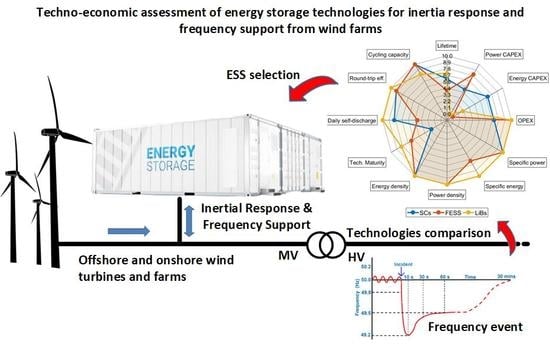Techno-Economic Assessment of Energy Storage Technologies for Inertia Response and Frequency Support from Wind Farms
Abstract
:1. Introduction
2. Review of the Current State of Literature Regarding Renewable Energy Sources Interfaced with Energy Storage and Their Provision of Virtual Inertia
3. Inertia Response and Frequency Support
3.1. Inertia Response
3.2. Frequency Support
4. Energy Storage Requirements, Potential Placement, and Candidate Technologies
4.1. Energy Storage System Requirements
- Sn—rated power of the wind turbine or wind farm where IR is to be implemented (in MW).
- H—equivalent inertia constant to be emulated (in seconds).
- —maximum RoCoF defined by the grid codes (in Hz/s).
- —maximum frequency deviation accepted by the grid operation code (in Hz).
4.2. Potential ESS Placement
4.3. Potential Control Strategies
4.4. Selection of Candidate ESS Technologies
5. Technical Discussion on ESS Candidates
5.1. Supercapacitors
5.2. Flywheels
5.3. Lithium Ion Batteries
- Lithium Cobalt Oxide (LCO or LiCoO2) released in 1991 and commercialized since 1994 by companies such as Sony and Samsung;
- Lithium Iron Phosphate (LFP or LiFePO4) commercialized since 1996 by companies such as SAFT and BYD;
- Lithium Nickel Cobalt Aluminum Oxide (NCA or LiNiCoAlO2) commercialized since 1999 by companies such as Panasonic and SAFT;
- Lithium Manganese Oxide (LMO or LiMn2O4) commercialized since 2002 by companies such as NEC, Samsung, and Hitachi);
- Lithium Nickel Manganese Cobalt Oxide (NMC or LiNiMnCoO2) commercialized since 2001 by companies such as LG Chem, Kokam, Samsung, or Panasonic;
- Lithium Titanate (LTO or Li4Ti5O12) commercialized since 2008 by Toshiba.
6. Comparison among ESS Alternatives
6.1. Comparing Weight and Volume
6.2. Comparing Lifetime
6.3. Comparing Cost
6.4. Final Discussion
7. Conclusions
8. Future Work
Author Contributions
Funding
Acknowledgments
Conflicts of Interest
Abbreviations
| EU | European Union |
| IR | Inertial response |
| UCTE | Union for the co-ordination of transmission of electricity |
| FS | Frequency support |
| PVCCI | Power voltage current control for inertia emulation |
| VSM | Virtual synchronous machine |
| WT | Wind turbine |
| FFR | Fast frequency response |
| PLL | Phase locked loop |
| ESS | Energy storage system |
| RoCoF | Rate of Change of Frequency |
| UK | United Kingdom |
| ENTSO-E | European Network of Transmission System Operators |
| DC | Direct current |
| AC | Alternating current |
| DFIG | Doubly-fed induction generator |
| BESS | Battery energy storage system |
| SC | Supercapacitor |
| FESS | Flywheel energy storage system |
| LiB | Lithium-ion battery |
| SMES | Superconducting magnetic energy storage |
| CAES | Compressed-air energy storage |
| HIC | Hybrid ion capacitors |
| LA | Lead-acid batteries |
| NaS | Sodium sulphur batteries |
| UC | Ultracapacitor |
| SOC | State of charge |
| SOH | State of health |
| UPS | Uninterruptible power supply |
| VRS | Voltage restorer systems |
| LCO | Lithium cobalt oxide |
| LFP | Lithium iron phosphate |
| NCA | Lithium nickel cobalt aluminum oxide |
| LMO | Lithium manganese oxide |
| NMC | Lithium nickel manganese cobalt oxide |
| LTO | Lithium titanate |
| CAPEX | Capital expenditure |
| OPEX | Operational expenditure |
References
- Wind Europe. Wind energy in Europe in 2018; Wind Europe: Brussels, Belgium, 2018. [Google Scholar]
- Milano, F.; Dörfler, F.; Hug, G.; Hill, D.J.; Verbič, G. Foundations and Challenges of Low-Inertia Systems (Invited Paper). In Proceedings of the 2018 Power Systems Computation Conference (PSCC), Dublin, Ireland, 11 June 2018; pp. 1–25. [Google Scholar] [CrossRef] [Green Version]
- National Grid ESO. Operability Strategy Report; National Grid ESO: Warwick, UK, 2019. [Google Scholar]
- Teng, F.; Mu, Y.; Jia, H.; Wu, J.; Zeng, P.; Strbac, G. Challenges on primary frequency control and potential solution from EVs in the future GB electricity system. Appl. Energy 2017, 194, 353–362. [Google Scholar] [CrossRef]
- O’Sullivan, J.; Rogers, A.; Flynn, D.; Smith, P.; Mullane, A.; O’Malley, M. Studying the Maximum Instantaneous Non-Synchronous Generation in an Island System—Frequency Stability Challenges in Ireland. IEEE Trans. Power Syst. 2014, 29, 2943–2951. [Google Scholar] [CrossRef] [Green Version]
- Kundur, P. Power System Stability and Control; McGraw-Hill Education: New York, NY, USA, 1995. [Google Scholar]
- Kerdphol, T.; Rahman, F.S.; Mitani, Y. Virtual Inertia Control Application to Enhance Frequency Stability of Interconnected Power Systems with High Renewable Energy Penetration. Energies 2018, 11, 981. [Google Scholar] [CrossRef] [Green Version]
- García-Ruiz, M.; Cantos-Alcántara, G.J.; Martínez-Ramos, J.L.; Marano-Marcolini, A. Minimum Required Inertia for a Fully Renewable AC Interconnected System. In Proceedings of the International Conference on Smart Energy Systems and Technologies (SEST), Porto, Portugal, 9 September 2019. [Google Scholar]
- Nguyen, H.T.; Yang, G.; Nielsen, A.H.; Jensen, P.H. Frequency stability improvement of low inertia systems using synchronous condensers. In Proceedings of the 2016 IEEE International Conference Smart Grid Commun. SmartGridComm, Sydney, Australia, 6 November 2016; pp. 650–655. [Google Scholar] [CrossRef]
- Gu, H.; Yan, R.; Saha, T.K. Minimum Synchronous Inertia Requirement of Renewable Power Systems. IEEE Trans. Power Syst. 2018, 33, 1533–1543. [Google Scholar] [CrossRef] [Green Version]
- Dreidy, M.; Mokhlis, H.; Mekhilef, S. Inertia response and frequency control techniques for renewable energy sources: A review. Renew. Sustain. Energy Rev. 2017, 69, 144–155. [Google Scholar] [CrossRef]
- Guan, M.; Pan, W.; Zhang, J.; Hao, Q.; Cheng, J.; Zheng, X. Synchronous Generator Emulation Control Strategy for Voltage Source Converter (VSC) Stations. IEEE Trans. Power Syst. 2015, 30, 1–9. [Google Scholar] [CrossRef]
- Miller, N.; Lew, D.; Piwko, R. Technology capabilities for fast frequency response. GE Energy Consulting, Tech. Rep 3; Australian Energy Market Operator: Melbourne, Australia, 2017. [Google Scholar]
- Morren, J.; De Haan, S.; Kling, W.L.; Ferreira, J. Wind Turbines Emulating Inertia and Supporting Primary Frequency Control. IEEE Trans. Power Syst. 2006, 21, 433–434. [Google Scholar] [CrossRef]
- Morren, J.; Pierik, J.; De Haan, S.W. Inertial response of variable speed wind turbines. Electr. Power Syst. Res. 2006, 76, 980–987. [Google Scholar] [CrossRef]
- Zhong, Q.-C.; Weiss, G. Synchronverters: Inverters That Mimic Synchronous Generators. IEEE Trans. Ind. Electron. 2010, 58, 1259–1267. [Google Scholar] [CrossRef]
- Henderson, C.; Vozikis, D.; Holliday, D.; Bian, X.; Egea-Àlvarez, A. Assessment of Grid-Connected Wind Turbines with an Inertia Response by Considering Internal Dynamics. Energies 2020, 13, 1038. [Google Scholar] [CrossRef] [Green Version]
- Sun, C.; Ali, S.Q.; Joos, G.; Bouffard, F. Virtual Synchronous Machine Control for Low-Inertia Power System Considering Energy Storage Limitation. In Proceedings of the ECCE 2019. IEEE Energy Conversion Congress & Expo, Baltimore, MD, USA, 29 September–3 October 2019. [Google Scholar] [CrossRef]
- Ma, Y.; Lin, Z.; Yu, R.; Zhao, S. Research on Improved VSG Control Algorithm Based on Capacity-Limited Energy Storage System. Energies 2018, 11, 677. [Google Scholar] [CrossRef] [Green Version]
- Arani, M.F.M.; El-Saadany, E.F. Implementing Virtual Inertia in DFIG-Based Wind Power Generation. IEEE Trans. Power Syst. 2012, 28, 1373–1384. [Google Scholar] [CrossRef]
- Fang, J.; Tang, Y.; Li, H.; Li, X. A Battery/Ultracapacitor Hybrid Energy Storage System for Implementing the Power Management of Virtual Synchronous Generators. IEEE Trans. Power Electron. 2018, 33, 2820–2824. [Google Scholar] [CrossRef]
- Schmidt, O.; Hawkes, A.D.; Gambhir, A.; Staffell, I. The future cost of electrical energy storage based on experience rates. Nat. Energy 2017, 2, 17110. [Google Scholar] [CrossRef]
- Fu, Y.; Wang, Y.; Zhang, X. Integrated wind turbine controller with virtual inertia and primary frequency responses for grid dynamic frequency support. IET Renew. Power Gener. 2017, 11, 1129–1137. [Google Scholar] [CrossRef]
- Ochoa, D.; Martínez, S.; Ochoa, D. Fast-Frequency Response Provided by DFIG-Wind Turbines and its Impact on the Grid. IEEE Trans. Power Syst. 2017, 32, 4002–4011. [Google Scholar] [CrossRef]
- D’Arco, S.; Suul, J.A.; Fosso, O.B. A Virtual Synchronous Machine implementation for distributed control of power converters in SmartGrids. Electr. Power Syst. Res. 2015, 122, 180–197. [Google Scholar] [CrossRef]
- Alsiraji, H.A.; El-Shatshat, R. Comprehensive assessment of virtual synchronous machine based voltage source converter controllers. IET Gener. Transm. Distrib. 2017, 11, 1762–1769. [Google Scholar] [CrossRef]
- Heydari, R.; Savaghebi, M.; Blaabjerg, F. Fast Frequency Control of Low-Inertia Hybrid Grid Utilizing Extended Virtual Synchronous Machine. In Proceedings of the 2020 11th Power Electronics, Drive Systems, and Technologies Conference (PEDSTC), Tehran, Iran, 4 February 2020. [Google Scholar] [CrossRef]
- Asensio, A.P.; Gonzalez-Longatt, F.; Arnaltes, S.; Rodriguez-Amenedo, J.L. Analysis of the Converter Synchronizing Method for the Contribution of Battery Energy Storage Systems to Inertia Emulation. Energies 2020, 13, 1478. [Google Scholar] [CrossRef] [Green Version]
- Yap, K.Y.; Sarimuthu, C.R.; Lim, J.M.-Y. Virtual Inertia-Based Inverters for Mitigating Frequency Instability in Grid-Connected Renewable Energy System: A Review. Appl. Sci. 2019, 9, 5300. [Google Scholar] [CrossRef] [Green Version]
- Ma, Y.; Cao, W.; Yang, L.; Wang, F.F.; Tolbert, L.M. Virtual Synchronous Generator Control of Full Converter Wind Turbines With Short-Term Energy Storage. IEEE Trans. Ind. Electron. 2017, 64, 8821–8831. [Google Scholar] [CrossRef]
- Liu, J.; Wen, J.; Long, Y.; Yao, W. Solution to short-term frequency response of wind farms by using energy storage systems. IET Renew. Power Gener. 2016, 10, 669–678. [Google Scholar] [CrossRef]
- Datta, U.; Kalam, A.; Shi, J. Battery Energy Storage System for Aggregated Inertia-Droop Control and a Novel Frequency Dependent State-of-Charge Recovery. Energies 2020, 13, 2003. [Google Scholar] [CrossRef] [Green Version]
- Othman, M.H.; Mokhlis, H.; Mubin, M.; Talpur, S.; Ab Aziz, N.F.; Dradi, M.; Mohamad, H. Progress in control and coordination of energy storage system-based VSG: A review. IET Renew. Power Gener. 2020, 14, 177–187. [Google Scholar] [CrossRef]
- Tamura, S. Economic Analysis of Hybrid Battery Energy Storage Systems Applied to Frequency Control in Power System. Electr. Eng. Jpn. 2015, 195, 24–31. [Google Scholar] [CrossRef]
- Atherton, J.; Sharma, R.; Salgado, J. Techno-economic analysis of energy storage systems for application in wind farms. Energy 2017, 135, 540–552. [Google Scholar] [CrossRef] [Green Version]
- Li, C. Techno-economic study of off-grid hybrid photovoltaic/battery and photovoltaic/battery/fuel cell power systems in Kunming, China. Energy Sources Part A Recover. Util. Environ. Eff. 2018, 41, 1588–1604. [Google Scholar] [CrossRef]
- Vaca, S.M.; Patsios, C.; Taylor, P. Enhancing frequency response of wind farms using hybrid energy storage systems. In Proceedings of the 2016 IEEE International Conference on Renewable Energy Research and Applications (ICRERA), Birmingham, Germany, 20 November 2016; pp. 325–329. [Google Scholar] [CrossRef] [Green Version]
- Chong, L.W.; Wong, Y.W.; Rajkumar, R.K.; Rajkumar, R.K.; Isa, D. Hybrid energy storage systems and control strategies for stand-alone renewable energy power systems. Renew. Sustain. Energy Rev. 2016, 66, 174–189. [Google Scholar] [CrossRef]
- Hajiaghasi, S.; Salemnia, A.; Hamzeh, M. Hybrid energy storage system for microgrids applications: A review. J. Energy Storage 2019, 21, 543–570. [Google Scholar] [CrossRef]
- Albu, M.; Visscher, K.; Creanga, D.; Nechifor, A.; Golovanov, N. Storage selection for DG applications containing Virtual Synchronous Generators. In Proceedings of the IEEE Bucharest Power Tech Conference, Bucharest, Romania, 28 June 2009. [Google Scholar]
- Akram, U.; Nadarajah, M.; Shah, R.; Milano, F. A review on rapid responsive energy storage technologies for frequency regulation in modern power systems. Renew. Sustain. Energy Rev. 2020, 120, 109626. [Google Scholar] [CrossRef]
- Li, J.; Ma, Y.; Mu, G.; Feng, X.; Yan, G.; Guo, G.; Zhang, T. Optimal Configuration of Energy Storage System Coordinating Wind Turbine to Participate Power System Primary Frequency Regulation. Energies 2018, 11, 1396. [Google Scholar] [CrossRef] [Green Version]
- Tsili, M.; Papathanassiou, S. A review of grid code technical requirements for wind farms. IET Renew. Power Gener. 2009, 3, 308. [Google Scholar] [CrossRef]
- National Grid Electricity System Operator. Available online: https://www.nationalgrideso.com/codes/grid-code (accessed on 31 August 2019).
- ENTSO-E. Rate of Change of Frequency (RoCoF) withstand Capability, ENTSO-E Guidance Document for National Implementation for Network Codes on Grid Connection; ENTSO-E: Brussels, Belgium, 2018. [Google Scholar]
- Ghofrani, M.; Arabali, A.; Etezadi-Amoli, M.; Fadali, M.S. A Framework for Optimal Placement of Energy Storage Units Within a Power System with High Wind Penetration. IEEE Trans. Sustain. Energy 2013, 4, 434–442. [Google Scholar] [CrossRef]
- Styczynski, Z.A. Electric Energy Storage and its tasks in the integration of wide-scale renewable resources. In Proceedings of the Integration of Wide-Scale Renewable Resources into the Power Delivery System, 2009 CIGRE/IEEE PES Joint Symposium, Calgary, AB, Canada, 29 July 2009; pp. 1–11. [Google Scholar]
- Hadjipaschalis, I.; Poullikkas, A.; Efthimiou, V. Overview of current and future energy storage technologies for electric power applications. Renew. Sustain. Energy Rev. 2009, 13, 1513–1522. [Google Scholar] [CrossRef]
- Hill, C.A.; Such, M.C.; Grady, W.M.; Chen, N.; Gonzalez, J. Battery Energy Storage for Enabling Integration of Distributed Solar Power Generation. IEEE Trans. Smart Grid 2012, 3, 850–857. [Google Scholar] [CrossRef]
- Nikolaidis, P.; Poullikkas, A. Cost metrics of electrical energy storage technologies in potential power system operations. Sustain. Energy Technol. Assessments 2018, 25, 43–59. [Google Scholar] [CrossRef]
- Luo, X.; Wang, J.; Dooner, M.; Clarke, J. Overview of current development in electrical energy storage technologies and the application potential in power system operation. Appl. Energy 2015, 137, 511–536. [Google Scholar] [CrossRef] [Green Version]
- Ali, M.H.; Wu, B.; Dougal, R.A. An Overview of SMES Applications in Power and Energy Systems. IEEE Trans. Sustain. Energy 2010, 1, 38–47. [Google Scholar] [CrossRef]
- Ngamroo, I.; Supriyadi, A.C.; Dechanupaprittha, S.; Mitani, Y. Power oscillation suppression by robust SMES in power system with large wind power penetration. Phys. C Supercond. 2009, 469, 44–51. [Google Scholar] [CrossRef]
- Lee, S.-S.; Kim, Y.-M.; Park, J.-K.; Moon, S.-I.; Yoon, Y.-T. Compressed Air Energy Storage Units for Power Generation and DSM in Korea. In Proceedings of the Power Engineering Society General Meeting, Tampa, FL, USA, 24 June 2007. [Google Scholar] [CrossRef]
- Swider, D.J. Compressed Air Energy Storage in an Electricity System With Significant Wind Power Generation. IEEE Trans. Energy Convers. 2007, 22, 95–102. [Google Scholar] [CrossRef]
- Abdon, A.; Zhang, X.; Parra, D.; Patel, M.K.; Bauer, C.; Worlitschek, J. Techno-economic and environmental assessment of stationary electricity storage technologies for different time scales. Energy 2017, 139, 1173–1187. [Google Scholar] [CrossRef]
- Ding, J.; Hu, W.; Paek, E.; Mitlin, D. Review of Hybrid Ion Capacitors: From Aqueous to Lithium to Sodium. Chem. Rev. 2018, 118, 6457–6498. [Google Scholar] [CrossRef] [PubMed]
- Roberts, B.P. Sodium-Sulfur (NaS) batteries for utility energy storage applications. In Proceedings of the Power and Energy Society General Meeting-Conversion and Delivery of Electrical Energy in the 21st Century, Pittsburgh, PA, USA, 20 July 2008. [Google Scholar] [CrossRef]
- Nichols, D.K.; Eckroad, S. Utility-scale application of sodium sulfur battery. In Proceedings of the IEEE International Stationary Battery Conference (Battcon’03), Marco Island, FL, USA, April 2003. [Google Scholar]
- Pullen, K. The Status and Future of Flywheel Energy Storage. Joule 2019, 3, 1394–1399. [Google Scholar] [CrossRef]
- Amiryar, M.; Pullen, K. A Review of Flywheel Energy Storage System Technologies and Their Applications. Appl. Sci. 2017, 7, 286. [Google Scholar] [CrossRef] [Green Version]
- Schneider, D. Silicon anodes will give lithiumion batteries a boost. IEEE Spectr. 2018, 56, 48–49. [Google Scholar] [CrossRef]
- Schneuwly, A. Maxwell Technologies White Paper-High Reliability Power Backup with Advanced Energy Storage; Maxwell Technologies, Inc.: San Diego, CA, USA, 2009. [Google Scholar]
- FREQCON GmbH. Ultracapacitor Grid Stabilizer. 2018. Available online: https://www.freqcon.com/wp-content/uploads/FREQCON-datasheet-grid-storage-ultracapacitor-grid-stabilizer.pdf (accessed on 7 September 2019).
- Pullen, K. Low Cost Flywheel Energy Storage: Supporting the Transformation to Renewables; Energy Institute-London and Home Counties Branch: London, UK, 2017; pp. 1–15. [Google Scholar]
- Chem, L.G. Global Catalog 2018. Available online: http://m.lgchem.com/upload/file/product/LGChem_Catalog_Global_2018.pdf (accessed on 7 September 2019).
- Moses 2020. Spider_Plot. Available online: https://www.github.com/NewGuy012/spider_plot (accessed on 13 June 2020).
- Barré, A.; Deguilhem, B.; Grolleau, S.; Gerard, M.; Suard, F.; Riu, D. A review on lithium-ion battery ageing mechanisms and estimations for automotive applications. J. Power Sources 2013, 241, 680–689. [Google Scholar] [CrossRef] [Green Version]
- Berecibar, M.; Gandiaga, I.; Villarreal, I.; Omar, N.; Van Mierlo, J.; Bossche, P.V.D. Critical review of state of health estimation methods of Li-ion batteries for real applications. Renew. Sustain. Energy Rev. 2016, 56, 572–587. [Google Scholar] [CrossRef]
- Beltran, H.; Garcia, I.T.; Alfonso-Gil, J.C.; Pérez, E.; Alfonso, J.C. Levelized Cost of Storage for Li-Ion Batteries Used in PV Power Plants for Ramp-Rate Control. IEEE Trans. Energy Convers. 2019, 34, 554–561. [Google Scholar] [CrossRef]
- El Brouji, E.-H.; Briat, O.; Vinassa, J.-M.; Bertrand, N.; Woirgard, E. Impact of Calendar Life and Cycling Ageing on Supercapacitor Performance. IEEE Trans. Veh. Technol. 2009, 58, 3917–3929. [Google Scholar] [CrossRef]
- D’Aprile, P.; Newman, J.; Pinner, D. The New Economics of Energy Storage; McKinsey & Co.: New York, NY, USA, 2016. [Google Scholar]
- International Renewable Energy Agency (IRENA). Electricity Storage And Renewables: Costs And Markets to 2030; International Renewable Energy Agency (IRENA): Abu Dhabi, UAE, 2017. [Google Scholar]
- Schmidt, O.; Melchior, S.; Hawkes, A.; Staffell, I. Projecting the future levelized cost of electricity storage technologies. Joule 2019, 3, 81–100. [Google Scholar] [CrossRef] [Green Version]
- Liebreich, M. Keynote-Bloomberg New Energy Finance Summit 2016; Bloomberg New Energy Finance: London, UK, 2016. [Google Scholar]
- Daly, P. Power System Inertia: Challenges & Solutions; Engineers Ireland: Dublin, Ireland, 2016. [Google Scholar]
- Jurasz, J.; Canales, F.A.; Kies, A.; Guezgouz, M.; Beluco, A. A review on the complementarity of renewable energy sources: Concept, metrics, application and future research directions. Solar Energy 2020, 195, 703–724. [Google Scholar] [CrossRef]
- Gallardo, R.P.; Ríos, A.M.; Ramírez, J.S. Analysis of the solar and wind energetic complementarity in Mexico. J. Clean. Prod. 2020, 268. [Google Scholar] [CrossRef]
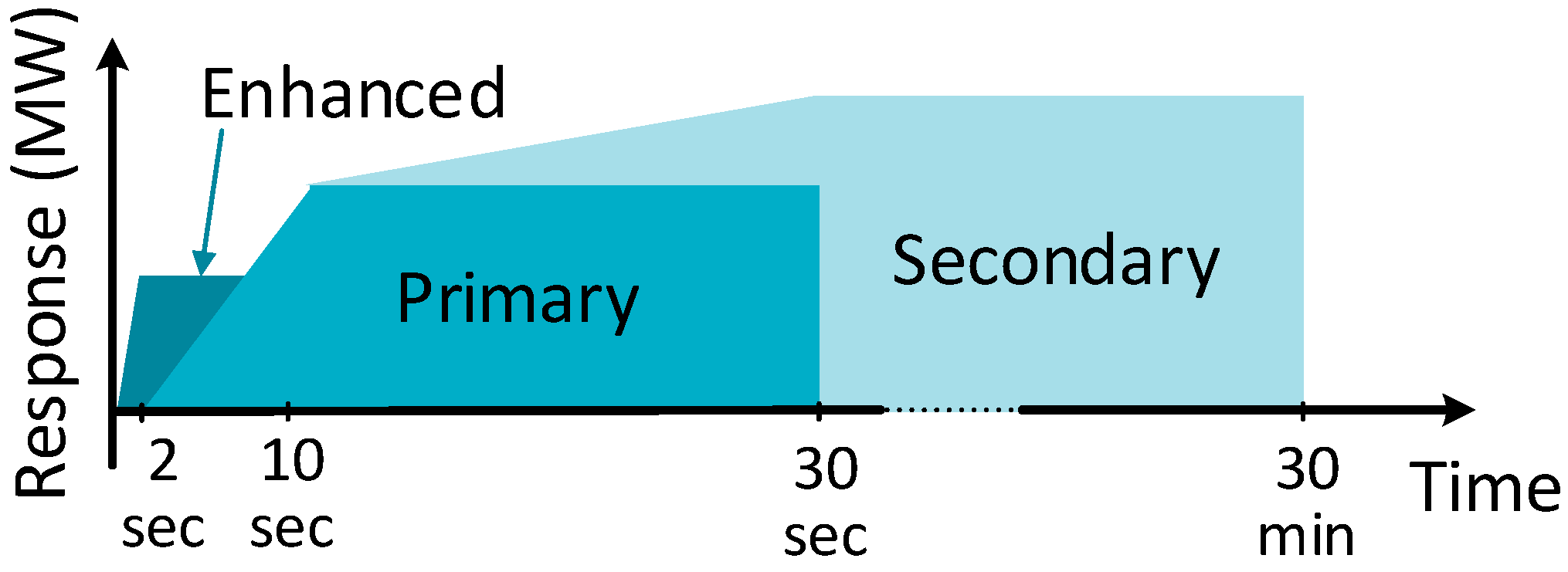

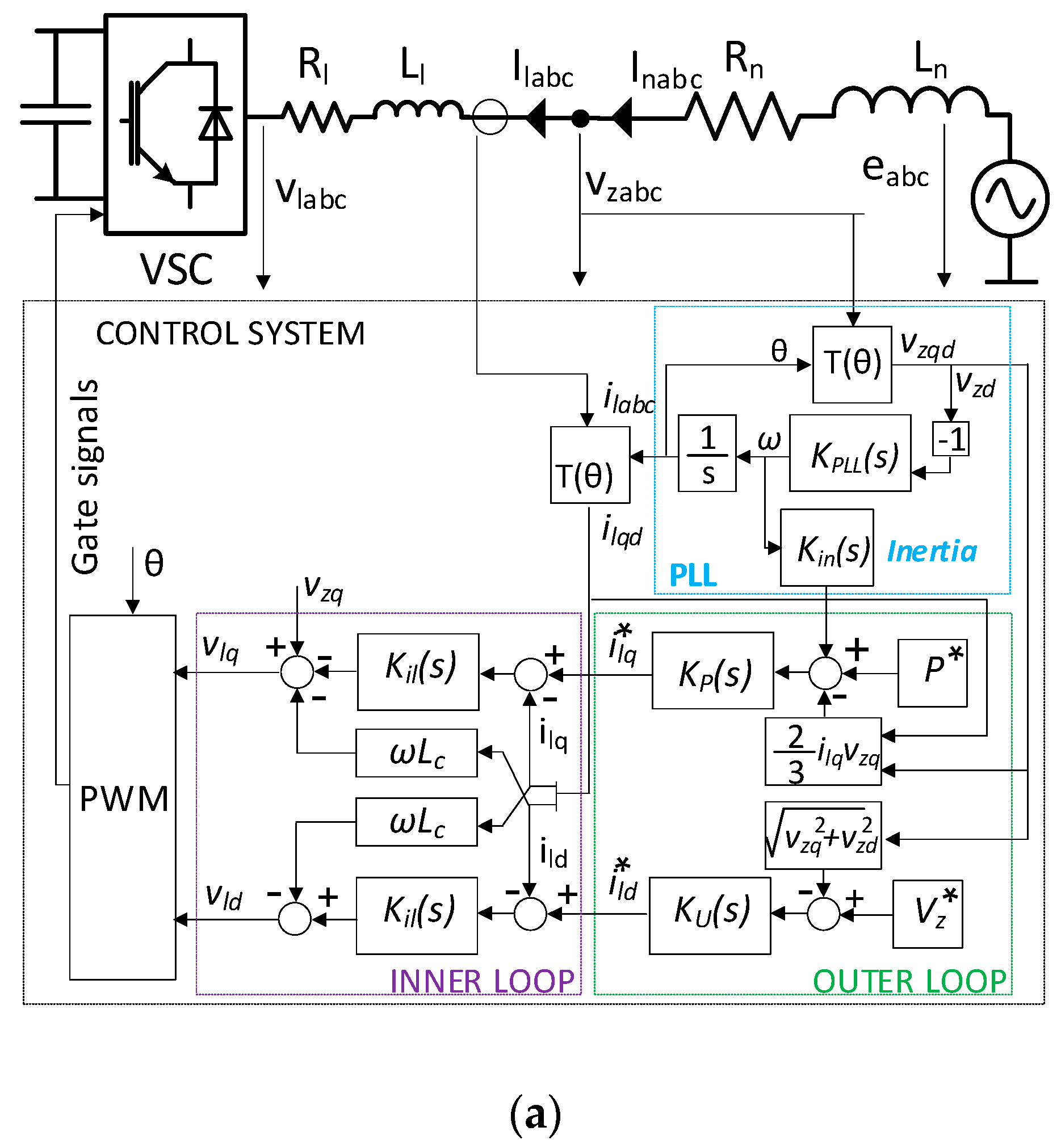

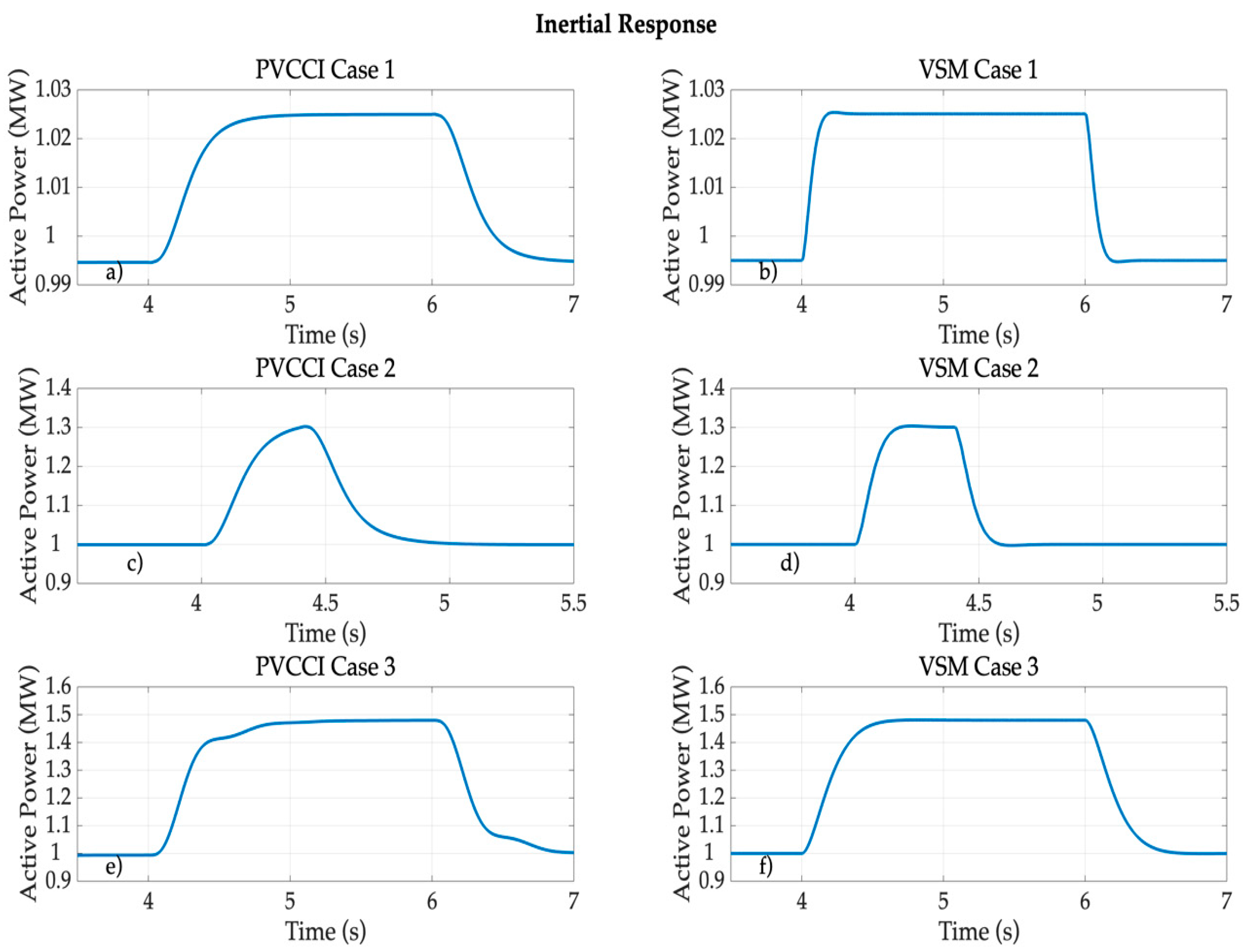

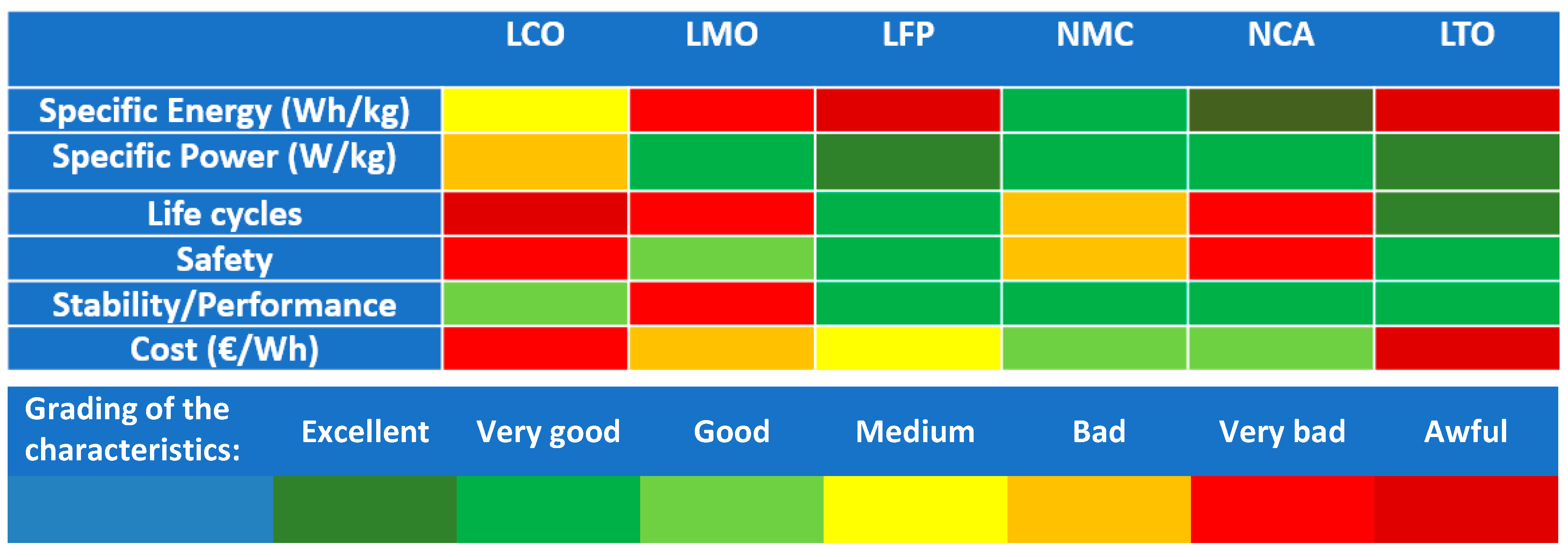
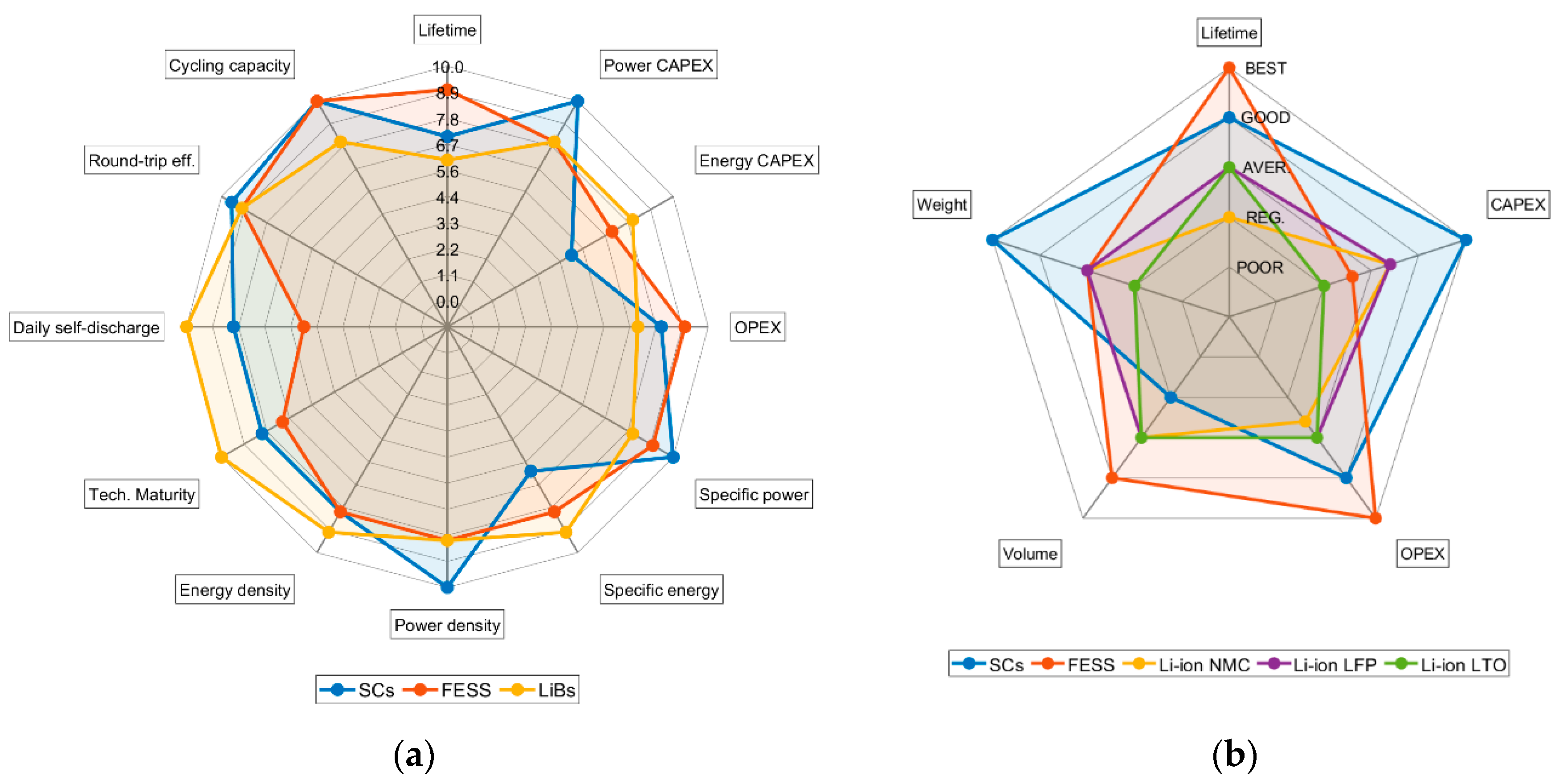
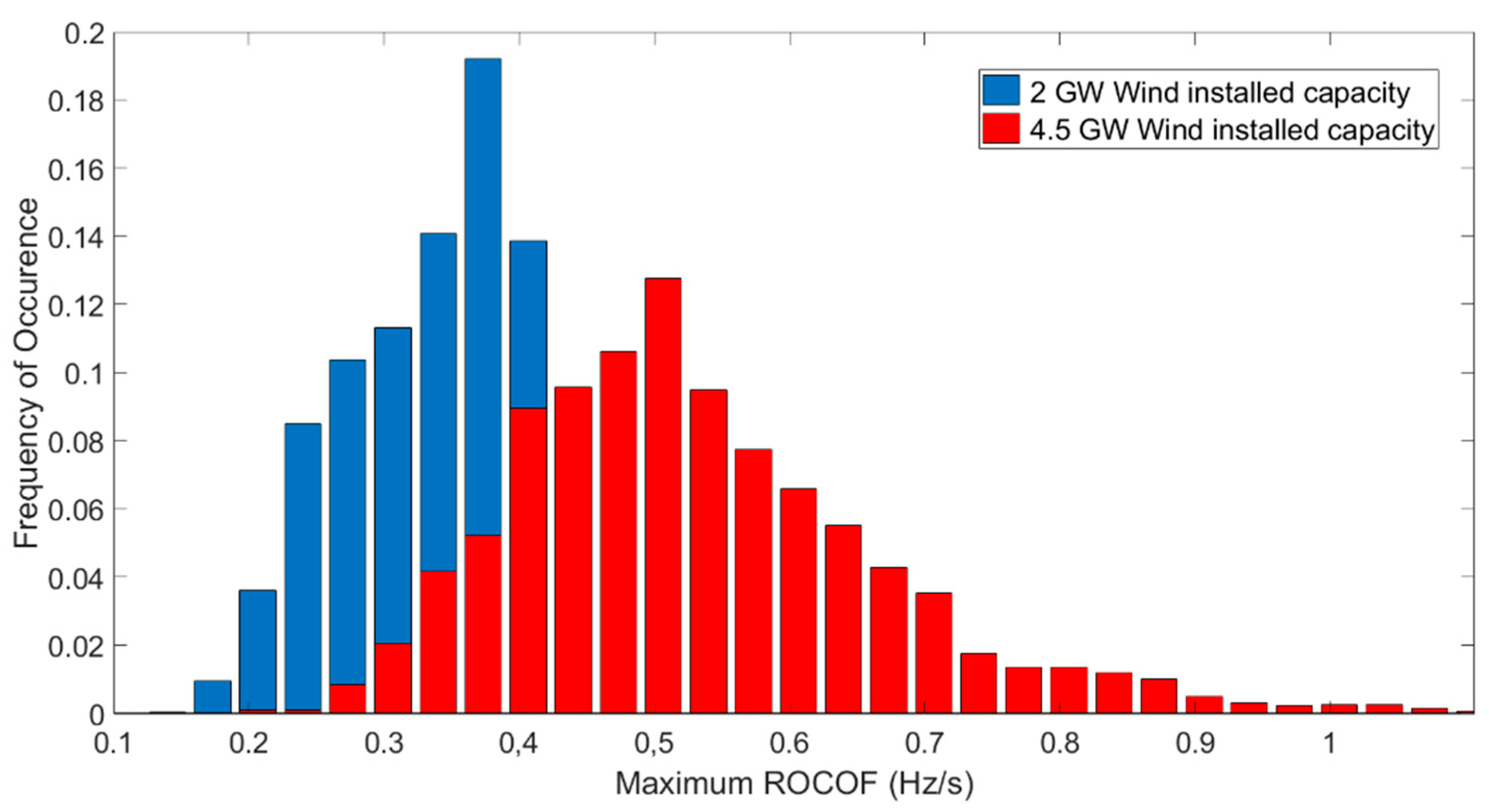
| Sn (MW) | H (s) | RoCoF (Hz/s) | Maximum Frequency Deviation (Hz) | Inertia Response Required Power (kW) | Inertia Response Required Energy (kWh) | Frequency Support for 10 s (kWh) | |
|---|---|---|---|---|---|---|---|
| Case 1 | 3 | 1 | 0.5 | 1 | 60 | 0.03 | 0.17 |
| Case 2 | 3 | 1 | 2.5 | 1 | 300 | 0.03 | 0.83 |
| Case 3 | 3 | 8 | 0.5 | 1 | 480 | 0.27 | 1.33 |
| Case 4 | 3 | 8 | 2.5 | 1 | 2400 | 0.27 | 6.67 |
| Case 5 | 3 | 1 | 0.5 | 5 | 60 | 0.17 | 0.17 |
| Case 6 | 3 | 1 | 2.5 | 5 | 300 | 0.17 | 0.83 |
| Case 7 | 3 | 8 | 0.5 | 5 | 480 | 1.33 | 1.33 |
| Case 8 | 3 | 8 | 2.5 | 5 | 2400 | 1.33 | 6.67 |
| Sn (MW) | H (s) | RoCoF (Hz/s) | Maximum Frequency Deviation (Hz) | Inertia Response Required Power (MW) | Inertia Response Required Energy (kWh) | Frequency Support for 10 s (kWh) | |
|---|---|---|---|---|---|---|---|
| Case 9 | 501 | 1 | 0.5 | 1 | 10 | 5.55 | 27.78 |
| Case 10 | 501 | 1 | 2.5 | 1 | 50 | 5.55 | 138.89 |
| Case 11 | 501 | 8 | 0.5 | 1 | 80 | 44.44 | 222.22 |
| Case 12 | 501 | 8 | 2.5 | 1 | 400 | 44.44 | 1111.1 |
| Case 13 | 501 | 1 | 0.5 | 5 | 10 | 27.77 | 27.78 |
| Case 14 | 501 | 1 | 2.5 | 5 | 50 | 27.77 | 138.89 |
| Case 15 | 501 | 8 | 0.5 | 5 | 80 | 222.22 | 222.22 |
| Case 16 | 501 | 8 | 2.5 | 5 | 400 | 222.22 | 1111.1 |
| H (s) | Pstorage (kW) | N | |||||
|---|---|---|---|---|---|---|---|
| Case 1 | 1 | 60 | 19,305 | 1 | 166.66 | ||
| Case 2 | 1 | 300 | 20,270 | 1 | 166.66 | ||
| Case 3 | 8 | 480 | 154,644 | 1 | 166.66 |
| Case 1 | 0.0331 | 0.0334 |
| Case 2 | 0.0348 | 0.0334 |
| Case 3 | 0.2643 | 0.2666 |
© 2020 by the authors. Licensee MDPI, Basel, Switzerland. This article is an open access article distributed under the terms and conditions of the Creative Commons Attribution (CC BY) license (http://creativecommons.org/licenses/by/4.0/).
Share and Cite
Beltran, H.; Harrison, S.; Egea-Àlvarez, A.; Xu, L. Techno-Economic Assessment of Energy Storage Technologies for Inertia Response and Frequency Support from Wind Farms. Energies 2020, 13, 3421. https://doi.org/10.3390/en13133421
Beltran H, Harrison S, Egea-Àlvarez A, Xu L. Techno-Economic Assessment of Energy Storage Technologies for Inertia Response and Frequency Support from Wind Farms. Energies. 2020; 13(13):3421. https://doi.org/10.3390/en13133421
Chicago/Turabian StyleBeltran, Hector, Sam Harrison, Agustí Egea-Àlvarez, and Lie Xu. 2020. "Techno-Economic Assessment of Energy Storage Technologies for Inertia Response and Frequency Support from Wind Farms" Energies 13, no. 13: 3421. https://doi.org/10.3390/en13133421
APA StyleBeltran, H., Harrison, S., Egea-Àlvarez, A., & Xu, L. (2020). Techno-Economic Assessment of Energy Storage Technologies for Inertia Response and Frequency Support from Wind Farms. Energies, 13(13), 3421. https://doi.org/10.3390/en13133421





